Natural connections
An app which brings scientists and the public together is exactly the kind of technology the world needs (12 minute read)
Outside of cities and suburbia, where they are neatly defined by gutters and footpaths, roadsides are ambiguous spaces. At times, they are part of the road and occupied by vehicles. At times, they are a place for pedestrians to walk. In some parts of the world, they provide a transit route or grazing for livestock. Adjacent landowners sometimes encroach with walls or fences, but mostly they are unoccupied spaces. Roadsides are accessible. And plants are left to their own devices there, or controlled only when they impinge on our power lines or drainage ditches.
Wherever I go in the world, I look at the plants on roadsides. I love them. I think I must be a roadside connoisseur. I have photographs of Kenyan roadsides, Canadian roadsides, Finnish roadsides, Niuean roadsides, Polish roadsides, Hawai’ian roadsides… you get the picture. I look through my photo collection, and it’s filled with roadside images.
In my discerning opinion, Western Australia has the best roadsides in the world. I was there nearly 20 years ago, in the spring, attending an invasive plant conference. The timing was no accident – it coincided with wildflower season. Before the conference began, I spent a day with some other botanists, simply driving around the fringes of Perth. Wherever we stopped, there were extraordinary plants growing right beside the road, with flowers in pink, yellow, white, purple, the clearest sky blue and even bright green flowers growing on red stems. Many of them were completely unfamiliar to me. I didn’t even know which botanical group they belonged to, which was an unusual experience, because I’m familiar with many of the common groups seen in roadside plants around the world.
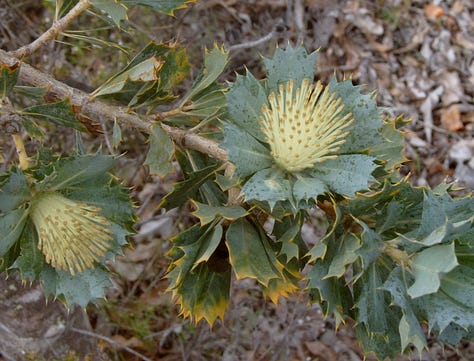
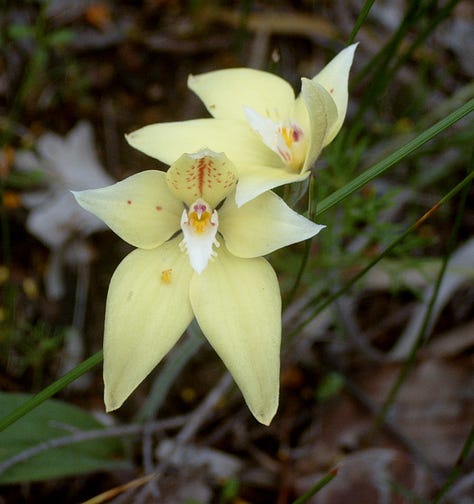
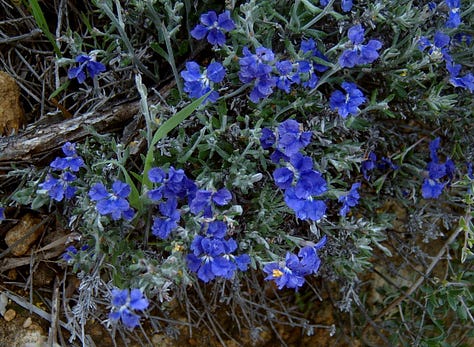

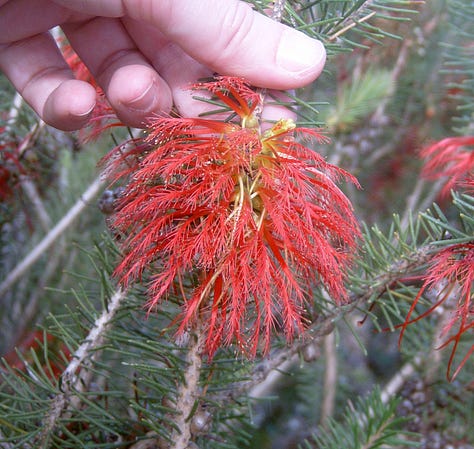
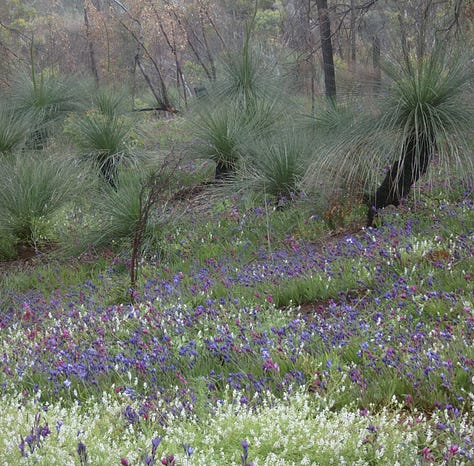
I was utterly entranced by the wildflowers I saw, even though I was only looking at roadsides, not even parks or reserves. There was one possible pitfall though – ant nests. I learned to pay close attention to the roadside gravel, because ants would tidy the gravel at the entrance to their nests. If the gravel was all the same size, a nest was probably nearby. Stepping on one was a mistake I made only once.
New Zealand has around 2300 flowering plants. The south-western corner of Western Australia, from Dirk Hartog Island on the west coast to the state border on the south coast, has over 5000, in an area only around 30% larger than New Zealand. Most of these plants are found nowhere else. The sheer number of species is overwhelming, even for experienced botanists. When I was there, it seemed as if every time I stopped by the side of the road, I was seeing completely different plants. Even if they had flowers and fruit, I had no idea what they were. I took photographs of as many as I could, in the hope that I would later be able to identify my images from one of the books I’d bought.
If I were to visit today, though, I would have another option. Around a year ago, I downloaded an app onto my phone and signed up to a community called iNaturalist. It’s a place where you can share photos of plants, animals, fungi, seaweeds and any other living thing, and have them identified by members of the community. I’ve seen iNaturalist described as Facebook for nature nerds, and there is something in that definition. In some ways it is like a social media site, you sign up, have your own profile, and interact with others on the site. But its main purpose is to record and share information about living things.
I’ve only been dipping my toes into the world of iNaturalist, but some people have made tens of thousands of observations on the site and are using it for serious research. I decided to get in touch with one of them, Thomas Mesaglio, who recently co-authored a paper on the quality of iNaturalist identifications for plants from south-west Western Australia. The paper got my attention, because I remembered how challenging plants of that region were.
One of the first things I asked Thomas was how he first became involved with iNaturalist. He tells me that it was in 2018, when he was doing a 6 month internship at the Australian Museum, in the entomology department. “In my lunchtimes, I would go around to the other departments and show the other curators photos on my phone or specimens I'd collected and ask them what they were. When I got to the fish department, I spoke to Mark McGrouther, who was the fish curator at the time. He said, ‘have you heard of something called iNaturalist? There’s a project called the Australasian Fishes Project. You should upload your photos there. There's people that can look at them and identify them for you’.
“So I joined that afternoon. My first hundred or so observations were dead fishes washed up on the beach, because that's what I had a lot of photos of. After a while, I realized there was a little bit more to it than dead fishes. I owe a tremendous debt of gratitude to Mark for getting me into iNaturalist, because it has literally been a life-changing experience.”
Thomas was always passionate about nature, and spent his childhood holidays exploring the bush and beach around his grandparents’ home in North Haven. But iNaturalist gave him the topic for the PhD he is now completing. “It's about improving our understanding of the Australian flora by integrating citizen science data with professional data. I’m getting herbarium records that have been collected by botanists over the centuries and then grabbing the iNaturalist records of plants from Australia that have been collected effectively in the last 10 years. I’m then integrating those two data streams to create kind of a 3rd new super stream of data where each of the two complement each other.”
This is a topic I can appreciate, because not only do I use iNaturalist, but many years ago I worked at the Allan Herbarium near Christchurch. A herbarium is a collection of dried plant specimens, which can be kept for centuries. The oldest specimens at the Allan Herbarium were collected by Joseph Banks and Daniel Solander in 1769. The oldest specimens collected in Australia were collected by William Dampier1 in 1699, although to my knowledge none of these are kept in Australia.
One strength of a herbarium record, Thomas explains, is the physical specimen. “It captures a fine level of detail that isn't always possible to capture in photographs, particularly with phone photographs. You can go back to it at any time, and examine it from any angle. You can look at the specimen under a microscope and even do things like take DNA samples from herbarium specimens.”
However, he points out that photographs have their strengths too. “There's a lot of groups where things like colour or particular structures get lost once they're pressed. Floral colour is a really important character that's very useful for identification in many groups, but once you press a plant, in many cases the colour gets lost very quickly. You may have a 50 or 60 year old herbarium specimen, and unless the collector wrote notes, nobody knows what colour some of the structures were. But if you have a photograph, of course it shows that very well.”
There are also important differences in where and what professional botanists and citizen scientists are recording. Thomas explains that “botanists are far, far better at collecting specimens of grasses, sedges and rushes than citizen scientists tend to be. We typically describe those as non-charismatic species, things that don't necessarily have big, showy flowers or aren't shrubs and trees. They will also go to more remote areas that tend to be away from population centres. You will definitely find better coverage of herbarium specimens from places off the beaten track, and areas that aren't necessarily accessible by the public as well.
“On the other hand, the citizen science records, that is, the iNaturalist photos, are good for the charismatic groups. So things like orchids, for example, are over-represented in citizen science data sets, particularly in comparison to herbarium specimens. Also, things with big showy flowers, groups like Banksia and Grevillea, or large shrubs and trees that are easy to photograph. And iNaturalist is good for fine resolution data that keeps showing from year to year that species are still present in particular locations.”
There’s another strength of iNaturalist, and it’s one I can appreciate. Thomas points out that iNaturalist “has a far better representation of common species. Almost paradoxically, a lot of common species tend to be underrepresented in herbarium collections.” This is something I know from my herbarium days. My botanical mentor, Bill Sykes, told a story about a curious gap in the Allan Herbarium specimens. He was working with two colleagues on a comprehensive volume about introduced plants in New Zealand. When they looked at the specimens, they found that there was almost no gorse, despite it being one of New Zealand’s most widespread and prominent weeds.
Gorse illustrates another strength of the iNaturalist records. It’s a solid mass of spines, and would have been unpleasant to collect and difficult to press. Thomas gives me another example, one which will be familiar to many in northern parts of New Zealand. “The classic one I can think of is the Canary Island palm [known in New Zealand as the phoenix palm]. It’s a bad weed in New South Wales, and particularly in Sydney. If you go around urban reserves, canals and waterways in Sydney, it's prolific. That's reflected in the iNaturalist records – there are hundreds of records in Sydney and in New South Wales. But if you look at the herbarium data, there's something like 2 specimens ever collected in Sydney. Because who's collecting a 20 metre palm frond with massive spines?”
But how reliable are the iNaturalist records? That’s been part of Thomas’s research. “Data quality has always been one of the big spectres hanging over citizen science. Whenever you get citizen science critics or sceptics, it's always data quality, and particularly identification accuracy, that gets raised as one of the misgivings about the platform. But often when this issue is raised, it's not based on actual studies and statistics. It's more of a vibe thing. It's the sense that the records are contributed by random people off the street, and identified by random people off the street, so they must be poor quality. But that’s often not objectively tested.
“Over the last 4 or 5 years there have been an increasing number of studies that have been looking at data quality across various groups. There have been mixed results, as you could expect. An American plant study had around 85% correctly identified. That was 5,000 records, including groups that were intentionally picked because they were challenging to identify. Some insect ones have been good too, there was a milkweed bug in the US where something like 98% of the 10,000 records were correctly identified. But on the other side, you have some of these lichen ones, which are looking at huge misidentification rates, which is not really too surprising, because a lot of these are groups that might need chemical tests or close up photographs.
“I was interested because there were no studies that had done anything for Australia. I thought it would be a good challenge with the Western Australian flora, since it’s so diverse. If there was going to be a data set that was going to have poor identification accuracy, then surely that would be it. It's a large flora. It's challenging to identify. We recruited 50 experts and we spent 3 weeks doing an identification blitz. Of 7,000 records which had been identified to species on iNaturalist, 92% of them were correctly identified. If you only took the research grade ones [one where at least two people have added an identification, and more than two thirds of them agree], it was up at around 97% correctly identified. I did not in all truthfulness expect it to be that high.”
The approach that iNaturalist uses for identification is unique, as far as I can tell. It combines image recognition by artificial intelligence or AI with human knowledge. When you enter a record, the AI will offer a suggestion, but then it’s other iNaturalist users who confirm or correct the name. Thomas tells me that he thinks that the AI “will never be able to fully replace human identifiers when it comes to natural history. But it does have a useful role to play in helping to lessen the burden for identifiers. If an AI can be trained to recognize a Koala in a photo or a rainbow lorikeet, do you really need a professional ornithologist to identify the rainbow lorikeet? If the robot can tell you that it's a rainbow lorikeet, that's totally fine by me. But then, if we start to talk about more esoteric groups of insects and plants and fungi, there's huge scope for the human identifiers to contribute. Having the AI suggestions is great for new users who often tend to be photographing the most common and easily identified species in the landscape. But it's fantastic that iNaturalist does have both.”
While iNaturalist is a great place to get your photographs identified, Thomas says that it’s much more than that. “The most fantastic part of iNaturalist, and how you get the most out of it, is by interacting with other people that use it. There are so many people from around the whole globe, experts, both professional and amateur, that have a wealth of knowledge to share. The only way that you're going to get access to that knowledge is by interacting with these members of the community.”
This is why I’ve become excited about what the iNaturalist community has to offer. It’s combining human expertise with technology to achieve something that neither could do alone. It’s connecting humans with the plants and animals around them, it’s connecting scientists and the public, and it’s connecting all kinds of people from around the world through their shared love of the natural world. Right now, iNaturalist is exactly the kind of technology that the world needs.
If you are feeling inspired to give iNaturalist a try, here’s the link to the website. I will be sharing some more information about iNaturalist on Sunday, including some announcements about opportunities to have a go next weekend, as part of the City Nature Challenge.
I’ll write about Dampier one day, because he’s one of my favourite historical figures.







Another factor iNaturalist uses when suggesting a possible ID from an image is to consider what has been found, or is expected to be found, in the vicinity of the observation. That can help a lot in making a correct ID, but I suppose is a bias against exceptional specimens.